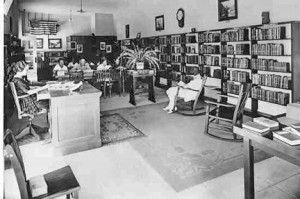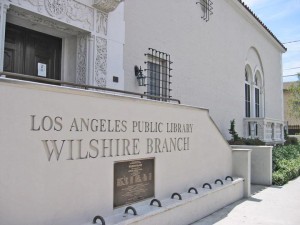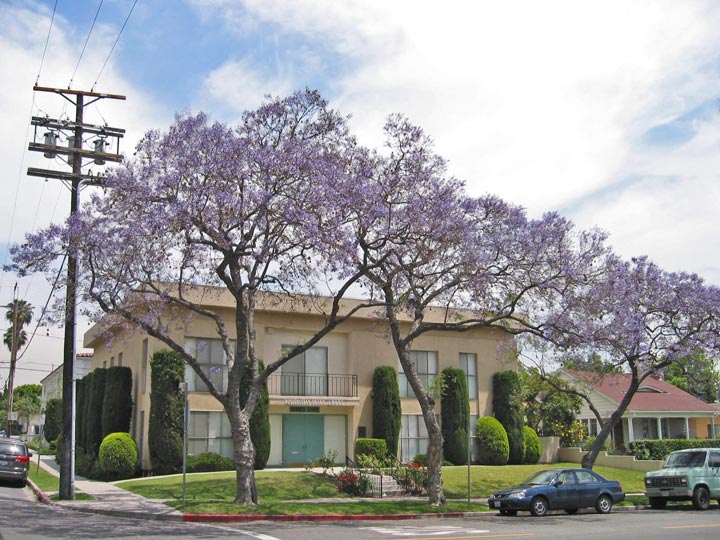The Early days of St. Andrew’s Square
It seems hard to comprehend today, but Western Avenue before 1910 was INDEED the western boundary of the City of Los Angeles. Streetcar lines coming from downtown ended at Western, and those commuters who happened to have built houses in the newly developing neighborhoods farther to the west had to walk the remaining distance home.
One of those early neighborhoods is now known as St. Andrews Square. It was largely developed by 1914, but according to some early residents, there were still unobstructed views of the nearby hills and mountain ranges and strong ocean breezes in the afternoons. Curiously enough, Beverly was once known as Temple St., Council was known as First St., and Third St. was once called Fourth.
Homes in St. Andrews Square were largely individually designed and illustrate as a group a considerable variety of building methods and styles—an attraction to motion picture and television production companies in choosing shooting locations. SASNA residents have included people from all walks of life—from actors, both struggling and famous, to zoology professors.
Buses have long since replaced the earlier streetcar lines; you can still ride both to the civic center and the Pacific Ocean itself. All of this contributes to making SASNA a pleasant and convenient place to reside: it is certainly an oasis in the city.
—Don McNamee
A Brief History of the Wilshire Branch Library
The Wilshire Branch of the Los Angeles Public Library opened December 6, 1920, in a tiny storefront building on Second and Hobart Streets, across from the Cahuenga School. It was
the smallest building ever occupied by any of the city’s branch libraries — a 12-by-24 foot space, length unbroken by doors or windows, with shelf space for only 1000 books. A scant 900 books started the branch’s collection, with loans from the Central Library “saving” Wilshire from collapse when a demanding, book-loving public checked out all the branches volumes within the first week of opening.
The area’s growth made it clear that a permanent site for the Wilshire Branch needed to be acquired quickly. In 1922, the Board of Library Commissioners approved a motion to purchase a lot on the southwest corner of St. Andrews Place and Council Street at a cost of $7,350 to ensure there would be a place for a new facility when funds became available to build one.
Passage of the 1925 Library Bond measure provided $500,000 to build facilities for fourteen new libraries, including the highly popular Wilshire Branch. Architect Allen Ruoff was chosen to design the new facility, which was scheduled for completion in 1927. But even with the prospect of a new building, it became necessary in 1926 for the Wilshire Branch to move to larger quarters. Two stores were rented on Western and Council to house the library until the new building could be built.
On August 1, 1927, the new Wilshire Branch Library was opened at a cost of $56,000. Italian  Renaissance in style, the building was constructed of stone tile with tufa stone trimming. The carved doorway featured an elaborate pattern of mythological animals, which was fashioned after the Portal of Costanzo, the famous Cathedral of Perugia, in Italy. With a large club room, the library now provided a place for community meetings. During World War II, the Wilshire Branch Library took an active part in community war interests, offering a hospitable meeting place for the Red Cross Unit, nutrition classes, a children’s Victory Club, and many other groups.
Renaissance in style, the building was constructed of stone tile with tufa stone trimming. The carved doorway featured an elaborate pattern of mythological animals, which was fashioned after the Portal of Costanzo, the famous Cathedral of Perugia, in Italy. With a large club room, the library now provided a place for community meetings. During World War II, the Wilshire Branch Library took an active part in community war interests, offering a hospitable meeting place for the Red Cross Unit, nutrition classes, a children’s Victory Club, and many other groups.
Through changing neighborhood demographics, the Wilshire Branch continued to serve the community at its St. Andrews Place location until October 1, 1987, when it was closed as a result of the Whittier Narrows earthquake. For the first time in fifty years, library service was interrupted. On July 28, 1988, the branch moved to temporary quarters at 316 N. Western Avenue, when the opening of the area’s new post office made it possible for the Library to move into the post office’s former quarters. Service to the community was restored, and efforts to rebuild the now-historic St. Andrews facility were begun.
Proposition 1, the 1989 bond issue, and grants from the Community Development Department have provided for renovation of the building. The renovations, designed by Barton Choy Associates, bring the building up to code, and ensure that the facility has the capabilities to meet the demands of a new century. The renovated historic structure reopened on August 8, 1996.
Did You Know?
One of the oldest institutions in our midst is the Rosicrucian Lodge located at 148 South Gramercy Place. It is Hermes Lodge #48, a branch of the Rosicrucian Order (AMORC), and
the oldest such lodge in Southern California. AMORC, which stands for Antiquus Mysticusque Ordo Rosae Crucis, is not a religion, but a fraternity dedicated to carrying on ancient mystery traditions said to have originated in Egypt.
Hermes Lodge #48, founded in 1927, spent a decade in temporary quarters until members purchased the house at 148 Gramercy Place for $12,500 dollars (with a down of $4,200). It was a two-story craftsman house, full of anterooms and closets, and, after some modification, well suited to the needs of the lodge. The new facility was dedicated on May 8, 1937. Its space, converted to temple use, included a Rose Temple where initiations took place; a Blue Temple and a Green Temple, used as classrooms; and a Convocation Temple; there were also wardrobes, dressing rooms, a library, offices, a kitchen and a garden house. In 1937, there were two “Convocations” every Sunday: one in English and one in Spanish.
After the earthquake of 1971 the building had to be torn down. For two years, members met at the Masonic Hall on Larchmont Boulevard. In January of 1972, a zone variance was granted (the 100-block of North Gramercy being strictly residential). The building we see now was finished in April of 1973. The lodge sponsors open meetings once a month, the third Wednesday, at 7:30.
–Henrietta Cosentino



Pingback: Weekend Buzz - Events for September 16-17, 2017 - Larchmont Buzz - Hancock Park News : Larchmont Buzz – Hancock Park News